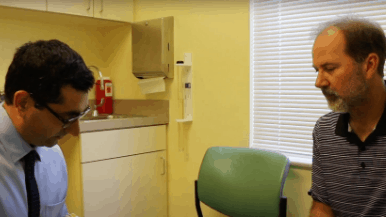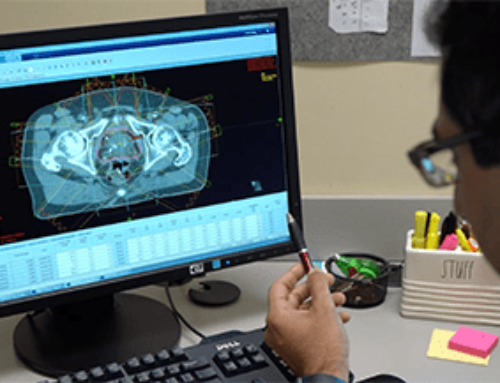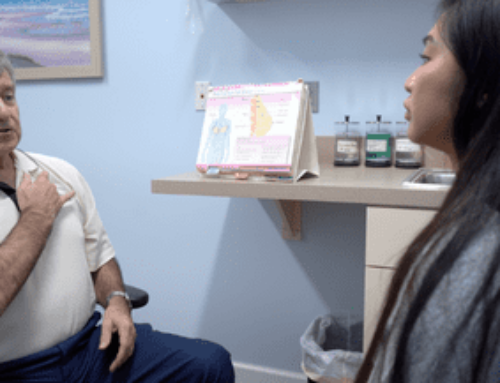- What is prostate cancer?
- When should I be screened for prostate cancer?
- What kinds of treatments are available for prostate cancer?
- What puts me more at risk for prostate cancer?
- What are the signs of prostate cancer?
The American Cancer Society says nearly 200,000 men in the U.S. are diagnosed with prostate cancer each year in the U.S. and 33,000 men die from the disease. One in every nine men is diagnosed with the illness at some point in their lifetimes.
Maneesh Gossain, M.D., board-certified radiation oncologist at the Central Florida Cancer Care Center says, “Prostate cancer is the second most common cancer and it’s something men should be focusing on and aware of.”
While prostate cancer is far too common to be ignored, many men put off screening for the disease, often until it’s too late to treat. When it comes to cancer, what you don’t know can hurt you. Here are 5 things men need to know about prostate cancer.
1. What is Prostate Cancer?
Prostate cancer is an abnormal growth of cells in the prostate. The prostate is a walnut-sized gland that produces semen deeply embedded in the groin area of the male body. It’s part of the male reproductive tract that includes the penis, seminal vesicles, and testicles. The prostate is located below the bladder in front of the rectum.
Prostate cancer occurs when normal cells become abnormal and start to divide rapidly and grow. There are several different types of prostate cancers, but all require immediate treatment from your doctor.
2. When Should I Be Screened for Prostate Cancer?
 Dr. Gossain suggests men should begin screening at age 50 for prostate cancer, or as early as 40 if they have a family history of the disease. When it comes to cancer, earlier detection gives better treatment options and can even save lives.
Dr. Gossain suggests men should begin screening at age 50 for prostate cancer, or as early as 40 if they have a family history of the disease. When it comes to cancer, earlier detection gives better treatment options and can even save lives.
The leading test for prostate cancer is called the PSA screening. The PSA is a blood test that measures the amount of prostate specific antigen, which is a protein produced by the prostate. PSA screening may also be accompanied by a digital rectal exam (DRE) to examine the prostate internally. A higher PSA means there is a greater chance of prostate cancer.
The prostate exam seeks to rule out other diseases that can stem from an enlarged prostate. This could include urinary tract issues or illnesses such as prostatitis, which is a bacterial condition causing the prostate to become inflamed and swollen. The PSA test is typically just the first in a series of screenings to determine the diagnosis of prostate cancer.
3. What Kinds of Treatments are Available for Prostate Cancer?
There are several treatment options available to treat prostate cancer and no single approach is best for every single patient. Some of the treatment options include:
- Surgery to remove the prostate may be an option if the cancer hasn’t spread to other parts of the body
- External beam radiation therapy for prostate cancer uses high-energy beams from an X-ray or proton beam to kill the irregular cells
- Brachytherapy is a type of radiation therapy that places a radioactive source directly into the prostate gland to kill the cancer cells
Each of these treatments has benefits and risks, but Dr. Gossain points out that there have been improvements over the years in surgical options as well as radiation treatment. These options now have fewer side effects and better success than ever before.
However, Dr. Gossain reiterates, “If we find early-stage patients with prostate cancer, the success rate is 90 percent plus. The later we find the cancers, the cure rate, and the remissions rate goes down.”
4. What Puts Me More at Risk for Prostate Cancer?
The Mayo Clinic says, “It’s not clear what causes prostate cancer.” We do know some of the risk factors that make you more susceptible to the disease.
The risk factors for prostate cancer include lifestyle choices, environment, and genetic history for the disease. Age is the greatest risk factor for developing prostate cancer. According to CancerConnect, it’s rare for a man under age 40 to develop the disease.
The American Cancer Society suggests other contributors to an increased risk for prostate cancer include:
- Chemical exposures can increase risk, such as exposure to Agent Orange used during the Vietnam War—although there is debate about this
- Diet seems to play a role; for example, men who eat a lot of dairy products appear to a have higher prostate cancer risk
- Genetic issues, such as the inherited BRCA1 or BRCA2 genes or men with Lynch syndrome
- Geography seems to play a role, with North American men more susceptible to prostate cancer than men living in Africa, Asia, Central, and South America
- Obesity may increase the risk of developing the disease, but there are conflicting studies in the scientific community
- Obesity does appear to put you at higher risk of developing a faster-growing form of the disease
- Prostate inflammation may play a factor, but, like chemical exposure, some studies suggest the opposite
- Race or ethnicity plays a factor, with African-American men more susceptible to the disease than Caucasian, Hispanic/Latino, or Asian-Americans
One behavior that puts you at risk for prostate cancer is failing to seek out regular prostate screenings with a PSA blood test and an exam from your doctor. Dr. Gossain states, “These are treatable issues for men. It’s easy to put it off, but you can save you and your family a lot of problems by getting screened.”
5. What Are the Signs of Prostate Cancer?
 In its early stages, men with prostate cancer may show no signs at all, which is why early detection preventative check-ups are so important. More advanced prostate cancer can appear as:
In its early stages, men with prostate cancer may show no signs at all, which is why early detection preventative check-ups are so important. More advanced prostate cancer can appear as:
- Blood in the urine or semen
- Bone pain
- Erectile dysfunction
- Trouble urinating and decreased force in the urine stream
- Unexplained weight loss
The goal is to catch the diseases in its early stages, which is why prostate screening is so important. Dr. Gossain says simply, “A screening can save your life.”
Central Florida Cancer Care Center is the leading radiation oncology treatment center in the region. We’re standing by to help. Contact us today.





